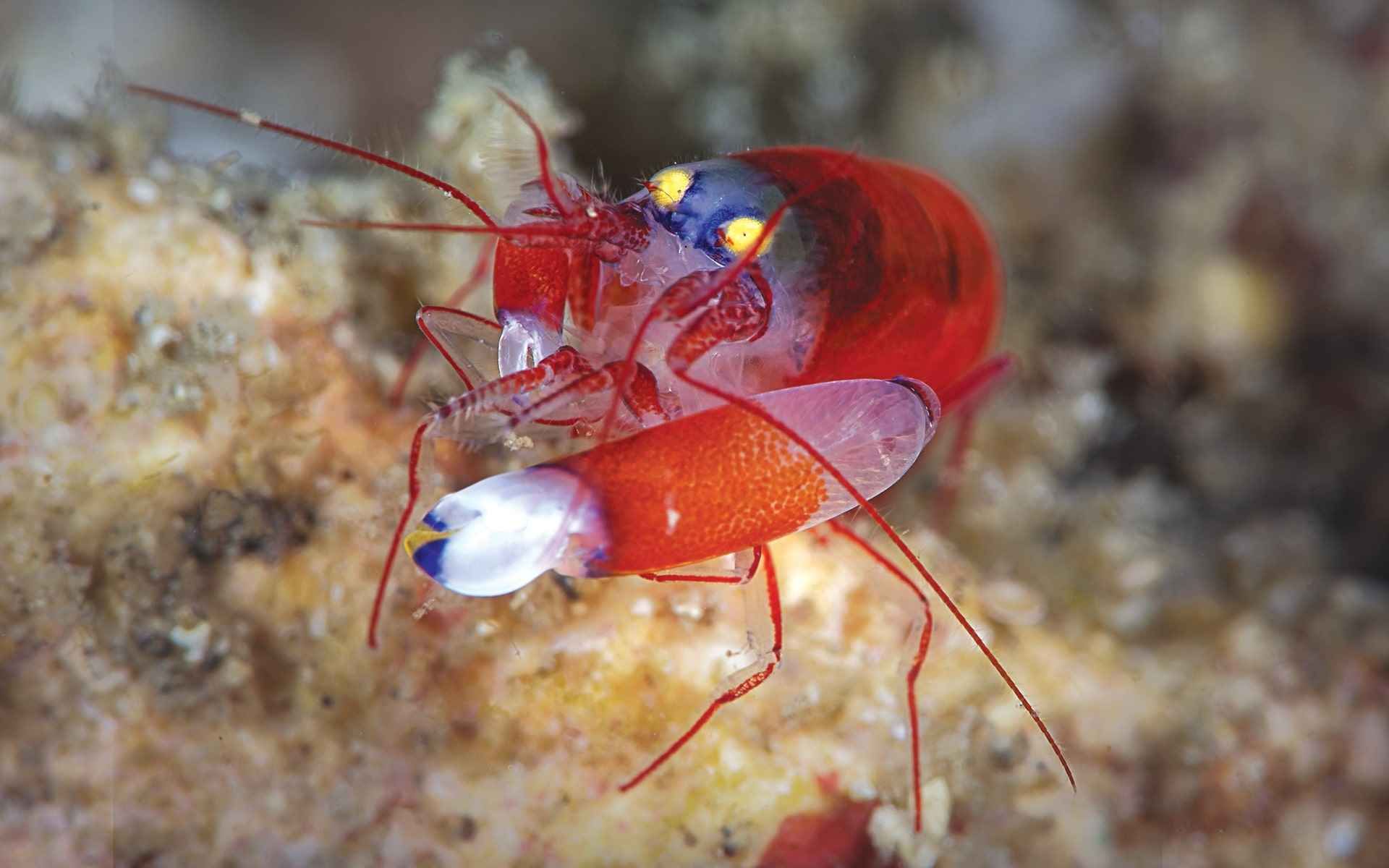Pistol Shrimp

In This Article
-
The pistol shrimp catches its prey with a sonic pistol it fires underwater. This tiny creature is endowed with a mind-blowing “gun” and amazing mechanisms so that it can seek out its sustenance.
-
Besides hunting their prey, pistol shrimps may also use their sonic pistols to dig burrows into rocks.
-
Pistol shrimps may exhibit lengthy symbiotic relationships in solidarity with other living beings.
Great explosions similar to those of pistol sounds are sometimes heard underwater. These loud sounds come from pistol shrimps, measuring only 3-5 cm in length. The “bullets” used by this animal consist of bubbles. The entire process is called sonoluminescence, in which water is energized with specific vibrations causing emission of light through bubbles. It was found that resulting temperatures can be as high as 4,400 °C.
The sounds produced when the pistols of these shrimps are fired are among the loudest sounds that can be heard in the oceans. The tiny shrimps compete with larger sperm whales and beluga whales for the title of the loudest animal in the oceans. When with their colonies, they can cause interference with sonar and underwater communication.
So how does this shrimp's "pistol" operate? How does it produce underwater "bullets" at such high temperatures? The pistol shrimp has two claws, one larger than the other. The larger claw, which is as large as half of the shrimp’s body, is the pistol. Unlike the smaller one, this claw does not have two symmetrical pincers, but two parts, one fixed (propus), the other moving (dactyl). The dactyl has a plunger which helps with the shrimp’s move. Its strong muscles allow the shrimp to snap its pistol claw with astonishing power. The explosion resulting from this miraculous snapping movement can generate an ear-splitting sound of 218 decibels and a maelstrom with a pressure of 80 kPa at its center. This strong sound wave is similar to a sonic boom. Thanks to this mechanism uniquely granted to it, the shrimp can easily hunt, knock out, and eat its prey.
When hunting, the shrimp hides itself in its underground burrow, patiently waiting for its prey to come within range. When prey comes within range it comes out of its hiding and fires up its pistol by snapping its claw with a very high speed. Coral reef biologist Nancy Knowlton of the Smithsonian Institute conducted studies on the chain of events that occur at this moment and explained that the resulting sound wave and highly heated bubble is fired up like a bullet. As the bubble bullet is hurtled forward with a speed of approximately 100 km per hour, a shock wave is created. The fired-up bubble implodes and its temperature reaches 4,400 °C all of a sudden. This astounding hunting event occurs in 300 microseconds only. As the bubble implodes, a sudden flash of light appears. However, the flashing of light is so sudden that the resulting light is not visible to the naked eye.
Besides hunting their prey, pistol shrimps may also use their sonic pistols to dig burrows into rocks. The impact from the firing up of their pistols is so powerful that they can dig proper burrows into hard basalt stones. In addition, these shrimps are known to attack their own kind. Similar to a Western duel they fire their pistols against each other at a close range to assert dominance. In this fight, shrimps may lose their claws. In this case, it was found, lost claws are re-grown. These shrimps may occasionally use their claws for communication as well.
Although they are equipped with a powerful weapon, pistol shrimps may exhibit lengthy symbiotic relationships in solidarity with other living beings. Some pistol shrimps may seek shelter in coral mazes while others live among the tentacles of sea anemones that resemble plants. Other species dig a burrow and invite a goby to share it. In this relationship, the goby provides advance warning against threats while the pistol shrimp assumes the task of building a safe burrow.
Some species of pistol shrimps establish colonies inside sponges. These shrimp communities, ruled by a king and a queen, were first identified by marine biologist Emmett Duffy. Duffy noted that this social union, rarely seen among marine animals, is similar to those observed among colonies of ants and bees. When these sponge-dwelling shrimps face with an intruder, they snap their claws rhythmically to send an alarm asking help from other group members.
The pistol shrimp is among the endless works of art we can observe and study in nature. Each and every one of these works of art urges us to wonder the infinite source of knowledge, power, will, wisdom, and mercy that enables them for our benefit.
References
- How It Works Book of Amazing Animals, Imagine Publishing Ltd. 2012, s. 53-54.
- Koukouvinis, Phoevos; Christoph Bruecker ve Manolis Gavaises, “Unveiling the physical mechanism behind pistol shrimp cavitation,” Scientific Reports | 7: 13994 | DOI:10.1038/s41598-017-14312-0, www.nature.com/articles/s41598-017-14312-0.pdf
- tr.wikipedia.org/wiki/Synalpheus_pinkfloydi
- en.wikipedia.org/wiki/Alpheidae
- video.nationalgeographic.com/video/worlds-deadliest/deadliest-pistol-shrimp
- www.wired.com/2014/07/absurd-creature-of-the-week-pistol-shrimp









